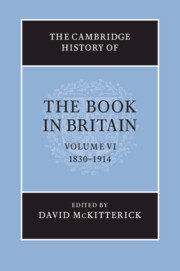Book contents
- Frontmatter
- Introduction
- 1 Changes in the look of the book
- 2 The illustration revolution
- 3 The serial revolution
- 4 Authorship
- 5 Copyright
- 6 Distribution
- 7 Reading
- 8 Mass markets: religion
- 9 Mass markets: education
- 10 Mass markets: children’s books
- 11 Mass markets: literature
- 12 Science, technology and mathematics
- 13 Publishing for leisure
- 14 Publishing for trades and professions
- 15 Organising knowledge in print
- 16 The information revolution
- 17 A place in the world
- 18 Second-hand and old books
- 19 A year of publishing: 1891
- 20 Following up The reading nation
- Bibliography
- Index
- Plate Sections
- References
9 - Mass markets: education
Published online by Cambridge University Press: 28 March 2010
- Frontmatter
- Introduction
- 1 Changes in the look of the book
- 2 The illustration revolution
- 3 The serial revolution
- 4 Authorship
- 5 Copyright
- 6 Distribution
- 7 Reading
- 8 Mass markets: religion
- 9 Mass markets: education
- 10 Mass markets: children’s books
- 11 Mass markets: literature
- 12 Science, technology and mathematics
- 13 Publishing for leisure
- 14 Publishing for trades and professions
- 15 Organising knowledge in print
- 16 The information revolution
- 17 A place in the world
- 18 Second-hand and old books
- 19 A year of publishing: 1891
- 20 Following up The reading nation
- Bibliography
- Index
- Plate Sections
- References
Summary
The technology of book production was transformed in the course of the nineteenth century and this is explored in detail elsewhere in this volume. In his ground-breaking work of 1994 Simon Eliot argued that one should look for two interrelated but distinct revolutions in book production, producing two great surges: 1830–55, the ‘distribution revolution’, underpinned by the impact of the Fourdrinier paper-making machine, steam-driven presses, case binding and the progressive abolition of the taxes on knowledge; and 1875–1914, the ‘mass-production revolution’, underpinned by rotary printing, hot metal typesetting, advances in the use of lithography and photography, and the replacement of steam by electricity. In symbiosis with these developments, feeding and feeding off them, was a series of transformations of the markets for books. This chapter will focus on one key sector, the markets created by the rise of formal schooling, and its associated phenomenon, the rise of public examinations, although it has to ask at least as many questions as it can attempt to answer.
The idea of a textbook in the modern sense solidified around 1830. The commonest spelling then was ‘text-book’; by the end of the century it had become ‘textbook’, perhaps suggesting a reification or embedding in parlance and usage. The emerging educational market was spotted immediately by the newly organising publishers. Fourteen London publishers began to produce the Publishers’ Circular in 1837; among them was Louis Fenwick de Porquet, one of the Frenchmen who fled after the Revolution and made a living teaching French in England; de Porquet was in turn teacher, author and publisher.
Keywords
- Type
- Chapter
- Information
- The Cambridge History of the Book in Britain , pp. 359 - 381Publisher: Cambridge University PressPrint publication year: 2009
References
- 1
- Cited by

